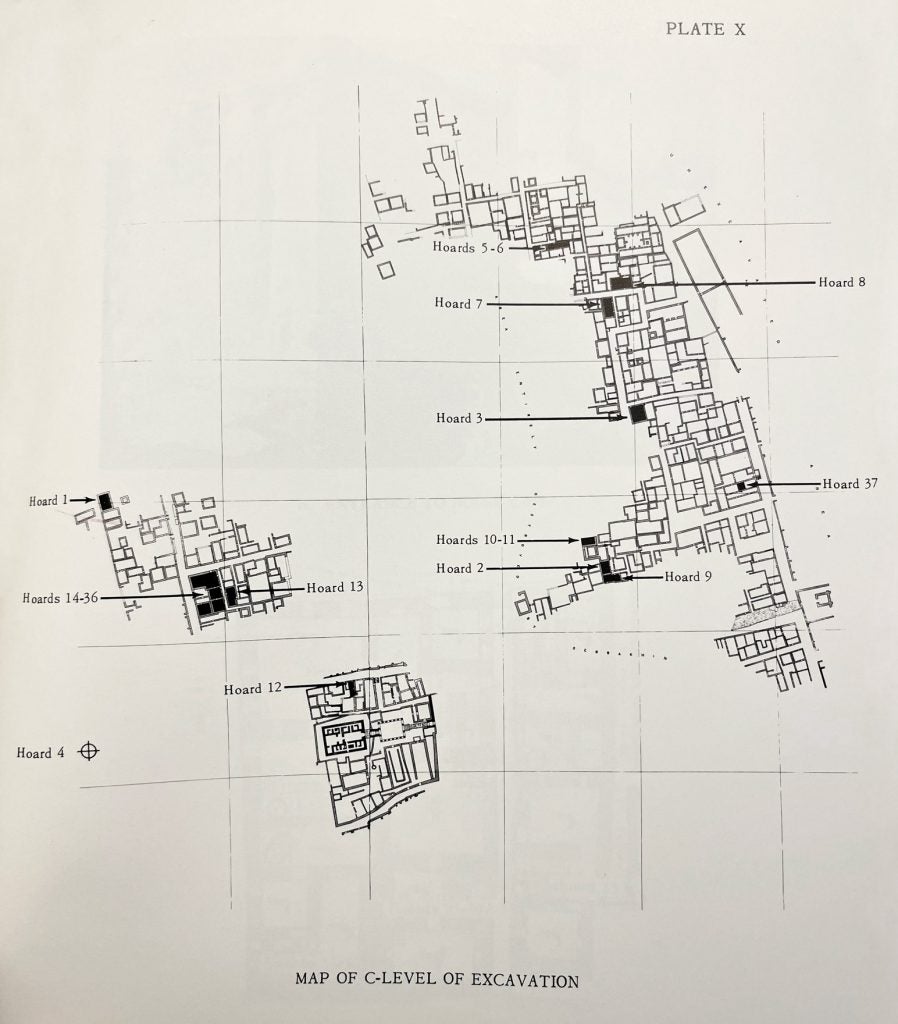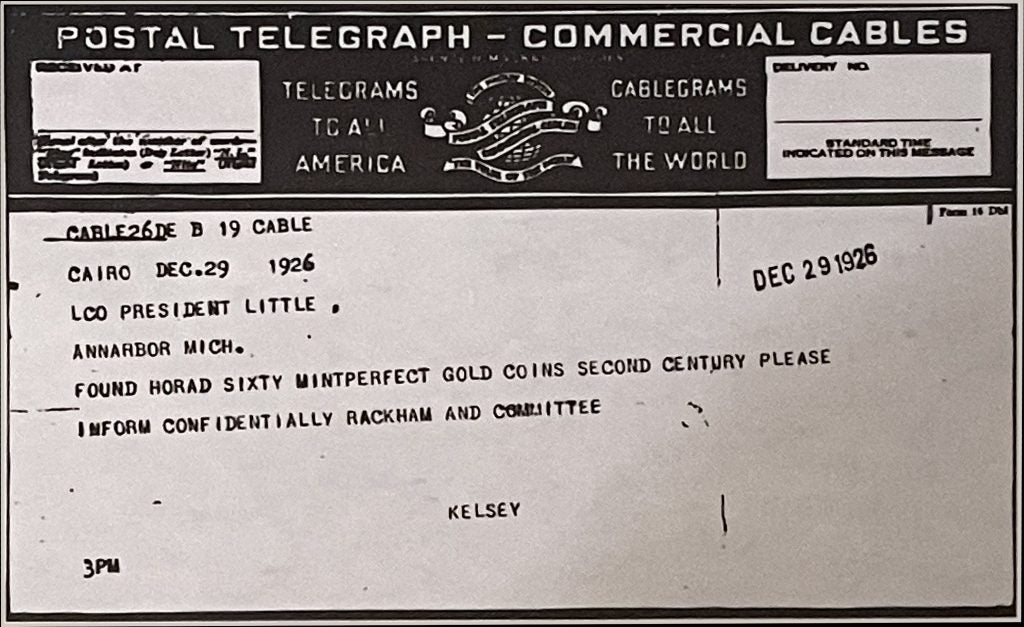
A hoard on display in the Kelsey Museum has been on my mind lately. Hoard 4 from Karanis, containing 60 Roman aurei, was found in a courtyard of B11, a second-century house at the site. The hoard had originally been stored in a cloth bag, whose only remnants were traces of mesh weave left in the soil around it. Some textile remains from a cloth bag were found nearby, possibly part of the original bag that held the coins (Haatvedt and Peterson 1964, 14–15).


Twenty-two coins were retained by the Department of Antiquities in Cairo (of Antoninus Pius, Marcus Aurelius, Faustina the Elder, and three of Faustina the Younger). The remaining 38 coins, now in the Kelsey Museum, are all dated from the fourth consulship of Antoninus Pius (156–157 CE), leading Haatvedt and Peterson to conclude that this is when the hoard was concealed.

We possess interesting documentation about the discovery of the hoard, such as this telegram sent from Francis Kelsey in Egypt to U-M president Clarence Cook Little. While the finding of any hoard in a secure archaeological context is cause for celebration, this particular hoard is interesting because it is one of the very few examples of the use of aurei in Egypt.
As I explained in the past two posts on Ptolemaic currency, a closed currency system was established in Egypt in 306 BCE by Ptolemy I, which continued throughout the duration of the dynasty. The conquest of Egypt by Augustus in 30 BCE brought about little change to the monetary system. Throughout the Roman period, Egypt remained a separate currency zone, meaning that only Egyptian coinage was officially minted and circulated in the province. So what were these aurei doing at Karanis?

New scholarship on the economic transition between Hellenistic and Roman Egypt has demonstrated that there is no evidence of any attempt to integrate the province monetarily with the rest of the Empire, as happened in the province of Asia, for example. Blouin and Burnett have recently concluded that it was only during the time of Nero (54–68 CE) that there was potential coordination of the coinage system across the whole Empire. During this time, monetary changes imposed in Rome, Crete, Syria, Cappadocia, and Egypt were meant to extract and recover silver for the Roman government (Blouin and Burnett 2020). Accordingly, throughout the Roman period, until the reforms of Diocletian in 297/98 CE, Egyptian currency retained the Greek system of denominations and dating. Coins, namely tetradrachms, continued to be made of billon, with lower denominations in bronze, and were minted only in Alexandria with some exceptions, such as when minting was conducted in Rome during the Flavian period. The coinage has been termed “Alexandrian coinage” in numismatics, and many studies have been undertaken on the reverse types of the coins, the iconography of which directly alludes to Graeco-Egyptian social, political, and religious culture (Geissen 2012, 566).

As the aureus is part of the traditional Roman monetary system, it was not part of the Egyptian Greek system of denominations still in place during this time. However, using precisely this evidence from Karanis, Erik Christiansen has demonstrated hoarding and active use of denarii and aurei in Egypt during the Roman period (Christiansen 2004). Whether gold coins circulated freely in Egypt or not is still contested. Blouin and Burnett’s article is the most recent discussion on the monetary integration of the Egyptian monetary system prior to the reforms of Diocletian, but we will talk about this issue in more depth in another blog post.
Further numismatic evidence from Karanis (to be discussed in the future) shows the close connection Egyptian tetradrachms had with Roman denarii, such as the empire-wide coinage reforms of Nero, which affected the Egyptian province, and later on, in 275, the introduction of the aureliani, which had been anticipated by the Alexandrian mint with a weight reduction in tetradrachms already in 274. I am not suggesting that Diocletian’s currency reform in Egypt was just a formality (the province did indeed have control over its own minting schedule), but I am suggesting that monetary boundaries are fluid and that it was perhaps only through the opening of the currency system that an interconnection between Egypt and the rest of the Mediterranean that had already been in place before the fourth century CE became visible. If possible, a closer assessment of third-century and pre-reform hoards may reveal the degree of permeability of the monetary horizon of Egypt’s closed currency system during the Roman period.
There is much more to say about this hoard and the utilization of outside coinage in Egypt prior to the reform by Diocletian, but it will have to wait until next time!
* * * * * * * * *
Bibliography
Blouin, Katherine, and Andrew Burnett. “From Kings to Emperors: The Development and Integration of the Egyptian Monetary System into the Roman Empire.” In Money Rules!: The Monetary Economy of Egypt, from Persians until the Beginning of Islam, edited by Thomas Faucher, 231–86. Bibliotheque d’etude 176. Cairo: Institut Français d’Archéologie Orientale, 2020.
Christiansen, Erik. Coinage in Roman Egypt: The Hoard Evidence. Aarhus: Aarhus University Press, 2004.
Geissen, A. “The Coinage of Roman Egypt.” In The Oxford Handbook of Greek and Roman Coinage, edited by William E. Metcalf, 561–83. Oxford: Oxford University Press, 2012.
Haatvedt, Rolfe Alden, and Enoch E. Peterson. Coins from Karanis, the University of Michigan Excavations, 1924–1935. Ann Arbor: Kelsey Museum of Archaeology, 1964.
